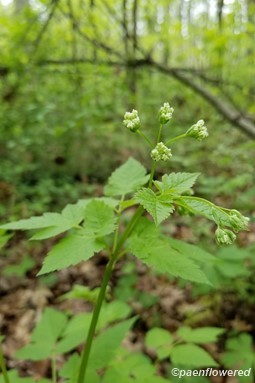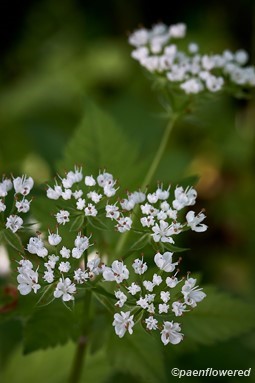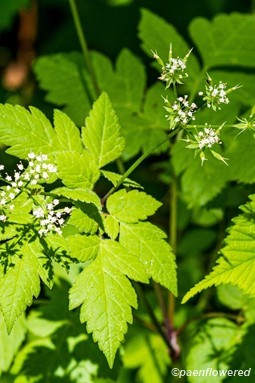Osmorhiza longistylis
A woodland plant with anise smell and white flower clusters on top of stems
Osmorhiza longistylis aniseroot
This perennial native plant is a member of the common carrot family and has characteristics typical of that group. The white flowers are very small (1/8 inch wide) and are found in flattened clusters (umbels) at the top of the plant. These clusters contain 8-16 individual flowers and a plant may have several flower clusters. A close look would show the individual flowers have five petals. There are 5 stamens and two white-tipped styles that project beyond the petals. At the base of each small flower cluster are hairy green bracts. The fruit is a narrow seed-like structure (schizocarp) about an inch long that is arched slightly and a bit swollen at the tip. It contains two seeds.
The main stem is usually smooth, though there may be some hairs on the upper stems and leaf stems. The stem color varies from green to reddish or purple. It has wide fernlike leaves divided into three yellow-green leaflets. Each is about 4 inches long and 2 inches wide. The leaflets may also be lobed or divided, but the terminal leaflet is the longest. The leaves are hairy, especially along the major veins on the underside and along the leaf stem. The lower leaves are large—often a foot or more long.
The carrot-like roots and crushed leaves have a sweet smell similar to anise or licorice and the root can be used as a substitute for black licorice. The genus name Osmorhiza translates from Latin as "scented root". This species grows in moist woods in southern Canada and in the eastern 2/3 of the United States. It is documented in most counties in Pennsylvania. It can grow from 2 to 3 feet high. It typically grows in woodlands in late spring and thus can tolerate some degree of shade. In this area, it normally blooms in May and June.
This species is also called long-style sweetroot or the smoother sweet root. It is often confused with the similar sweet cicely (Osmorhiza claytonii), which blooms about the same time. Sweet cicely, however, has fewer flowers in the clusters (4-7), a scent that is less strong, and a hairy flower stalk. The latter characteristic is the best way to tell the two species apart.
Habitat & Range
Grows in rich woods, moist wooded slopes, and thickets.
Present throughout the state.
Range: Southern Canada and in the eastern 2/3 of the United States
| EMP: | FACU |
|---|---|
| NCNE: | FACU |
Phenology
Flowers May to early June.
Plant Codes
S-rank: S5 (Secure)
G-rank: G5 (Secure)








Comments
Have you spotted this plant in your area? We'd love to hear about your experience! Share your comments or questions about the plant below. Comments are moderated before posting.